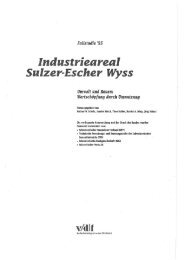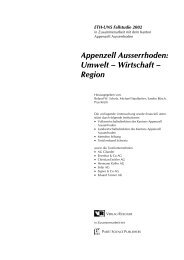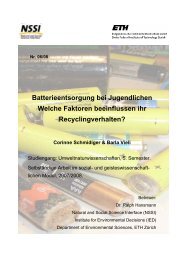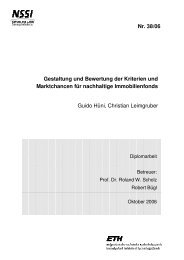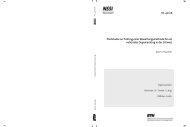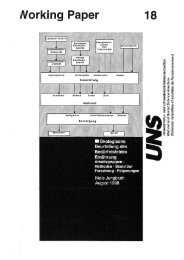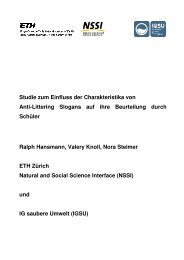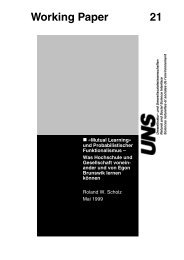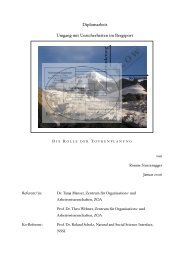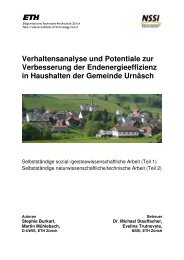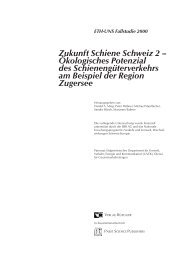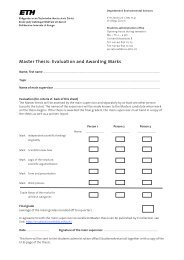Non-road fuel consumption and pollutant emissions ... - BAFU - CH
Non-road fuel consumption and pollutant emissions ... - BAFU - CH
Non-road fuel consumption and pollutant emissions ... - BAFU - CH
Create successful ePaper yourself
Turn your PDF publications into a flip-book with our unique Google optimized e-Paper software.
<strong>Non</strong>-<strong>road</strong> <strong>fuel</strong> <strong>consumption</strong> <strong>and</strong> <strong>pollutant</strong> <strong>emissions</strong> FOEN 2008 106<br />
Tab. 14 > Comparison with emission <strong>and</strong> <strong>consumption</strong> factors in Report 49 (in g per kwh)<br />
The listed emission factors refer to all non-<strong>road</strong> machines equipped with a diesel engine<br />
(except ships/boats <strong>and</strong> railway vehicles).<br />
A: adjusted emission factors (including type of construction <strong>and</strong> wear <strong>and</strong> tear)<br />
according to Table A3.1a in Report 49.<br />
B: emission factors (“Previous” = according to data in Fig. A2.6 in Report 49).<br />
Engine-power class<br />
CO HC NOX PM<br />
Previous New Previous New Previous New Previous New<br />
A B B A B B A B B A B B<br />
130 kW 3.1 2.9 3.62 1.3 1.3 0.91 14.3 9.8 12.52 1.3 1.0 0.61<br />
As we can see from Table 14, the new emission factors for diesel machines concerning<br />
HC <strong>and</strong> PM are up to 50% lower than the emission factors used in Report 49.<br />
9.3.3 Inventories <strong>and</strong> operating hours<br />
For the purpose of comparing the figures for the new non-<strong>road</strong> inventory with the data<br />
previously used by the FOEN from Report 49 (SAEFL 1996a), 2005 was chosen as<br />
reference year. The figures in Report 49 are taken from the corresponding technical<br />
appendix (SAEFL 1996b).<br />
Figure 53 (top) compares the figures for the new non-<strong>road</strong> inventories <strong>and</strong> operating<br />
hours with those published in Report 49, distinguished by engine type. In addition, the<br />
specific operating hours, i.e. per machine <strong>and</strong> year, <strong>and</strong> the ratio between the figures<br />
for the new non-<strong>road</strong> inventory <strong>and</strong> operating hours <strong>and</strong> those presented in Report 49,<br />
are shown in Figure 53 (bottom). Here we can see that there are significant differences,<br />
especially regarding construction, industrial, agricultural, forestry, railway <strong>and</strong> military<br />
machinery.<br />
Although the inventory in Report 49 does not include any construction machines<br />
equipped with a petrol engine, the number of construction machines assumed in that<br />
report for 2005 was around twice as high as in the new non-<strong>road</strong> inventory.<br />
The number of industrial machines in the new inventory is slightly higher than in<br />
Report 49, partly because snow groomers now form a new sub-segment of their own.<br />
In the new non-<strong>road</strong> inventory, forklifts were included separately for the first time<br />
(with a total of 17 000 vehicles) in 2005. At the same time, the inventory of industrial<br />
carts was reduced from 16,800 to 3200.<br />
Construction machinery<br />
Industrial machinery



